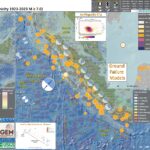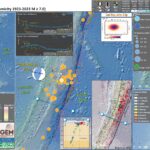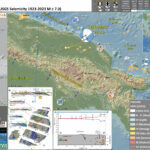As I completed the Earthquake Report for yesterday’s M 7.1 earthquake along the Kermadec Trench, I tweeted the report and interpretive poster to notice a colleague had tweeted about a magnitude M 7.1 earthquake about an hour earlier. So, I…
Earthquake Report: M 7.1 Kermadec
I am currently taking a break following an excellent Seismological Society of America Meeting in San Juan Puerto Rico. I presented a couple posters and one talk on the results from our USGS Powell Center meeting where we developed a…
Earthquake Report: M 7.0 Papua New Guinea
This morning (my time) I received a notification from the National Tsunami Warning Center, the organization responsible for generating notifications for my locality (California). There was a magnitude M 7.0 earthquake in Papua New Guinea. https://earthquake.usgs.gov/earthquakes/eventpage/at00rsi26z/executive This earthquake was almost…



